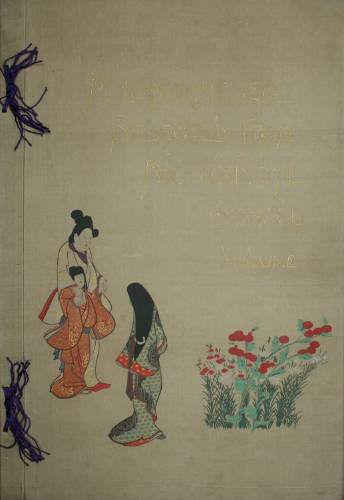Tajima Shiichi (editor)
Omura Seigai (text)
Goodrich, Joseph King (translation into English):
Masterpieces Selected from the Ukiyoye School (Eibun Ukiyoe-Ha Gashu), Shimbi Shoin, Tokyo, 1906, Volume I of a five volume set, folio (13 1/2 x 19 1/2 in - 34.2 x 49.5 cm), silk covered boards with a woodblock illustration on the front board, edges beveled, spine covered in decorated silk cloth, purple silk ties, title in English in gilt on front board, top and bottom page edges in gilt, text in English, 40 plates (33 color woodblock and 7 black and white collotype), 40 text pages (preface - v-viii and numbered pages 1-36). Each plate is preceded by a tissue guard with information in English regarding the plate that follows. There are numerous black and white text illustrations in the text pages. While most are woodcuts, a few are collotypes. Issued with a straw textured wrap-around case with ivory type clasps. According to Shimbi Shoin catalogues "Regular," "Special" and "De Luxe" editions were issued. Each volume contains a numbered limitation statement indicating the number of the set out of total sets printed.
Volume I deals with:
- Genre Before and About the Keicho and the Kwanyei Parts (1596-1643)
- Matabei Iwasa
- The Hishikawa School.
The following schools and artists are discussed and their art reproduced: Kano School, Tosa School, Hideyori Kano, Naisen Kano, Matabei Iwasa, Moronobu Hishikawa, Morofusa Hishikawa, Moroshige Hishikawa, Morohira Hishikawa, Wawo Hishikawa, Tomofusa Hishikawa, Morotsugi Furuyama and Moromasa Furuyama.
For more information on the complete five volume set, see below.
Text Pages
Preface
List of Plates
Illustrated Limitation page
("Special Edition" No. 300)
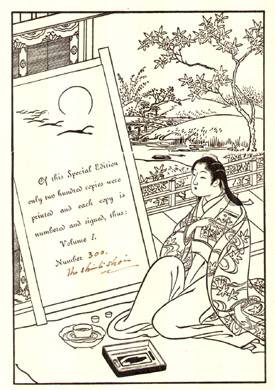 Title Page
Title Page
 Example of Descriptive Tissue Guard
Example of Descriptive Tissue Guard
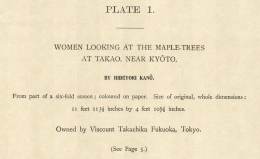 Text Pages
Pages
Preface Pages v-viii 4
Listing of Plates Unnumbered
Part I Pages 1-14 14
Part II Pages 15-24 10
Part III Pages 25-36 12
Total Text Pages -- 36 + 4 unnumbered pages of preface
Part I. Genre Before and About the Keicho and the
Kwanyei Parts (1596-1643) - Plates 1-16
Part II. Matabei Iwasa - Plates 17-27
Part III. The Hishikawa School - Plates 28-40
Chapter I. Moronobu Hishikawa
Chapter II. Morofusa Hishikawa
Chapter III. Moroshigi Hishikawa
Chapter IV. Morohiga Hishikawa
Chapter V. Wano Hishikawa
Chapter VI. Tomfusa Hishikawa
Chapter VII. Morotsugi Furuyama
Chapter VIII. Moromasa Furuyama
Text Pages
Pages
Preface Pages v-viii 4
Listing of Plates Unnumbered
Part I Pages 1-14 14
Part II Pages 15-24 10
Part III Pages 25-36 12
Total Text Pages -- 36 + 4 unnumbered pages of preface
Part I. Genre Before and About the Keicho and the
Kwanyei Parts (1596-1643) - Plates 1-16
Part II. Matabei Iwasa - Plates 17-27
Part III. The Hishikawa School - Plates 28-40
Chapter I. Moronobu Hishikawa
Chapter II. Morofusa Hishikawa
Chapter III. Moroshigi Hishikawa
Chapter IV. Morohiga Hishikawa
Chapter V. Wano Hishikawa
Chapter VI. Tomfusa Hishikawa
Chapter VII. Morotsugi Furuyama
Chapter VIII. Moromasa Furuyama
Plates(Color Except for the 8 Underlined Plates)
Volume I. List of Plates
1. Women Looking at The Maple-Trees at Takao,
near Kyoto By Hideyori Kano
 2-3. The Festival of Toyokuni Daimyojin By Naisen Kano
2-3. The Festival of Toyokuni Daimyojin By Naisen Kano
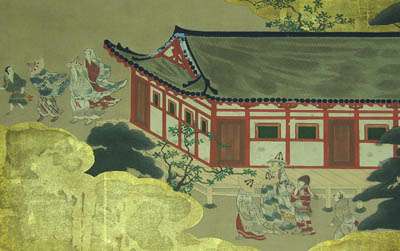
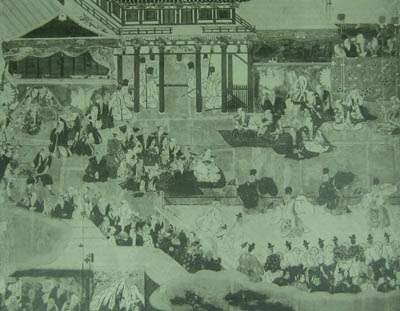 4. Ship being Unloaded Kano School
4. Ship being Unloaded Kano School
 5. House Building Kano School
5. House Building Kano School
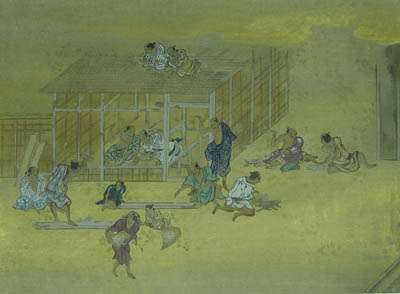 6. Shooting Kano School
6. Shooting Kano School
 7. Horse Training Kano School
7. Horse Training Kano School
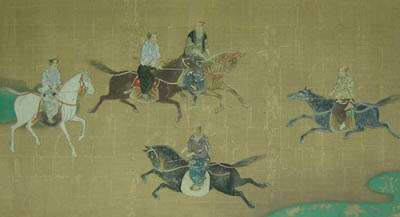 8. The Hikone Screen Kano School
8. The Hikone Screen Kano School
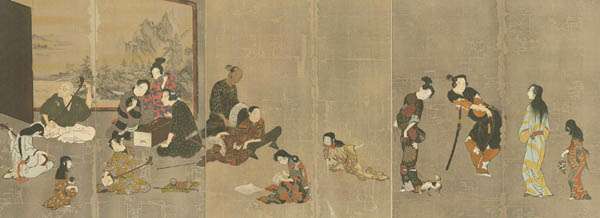 9. Women Tranquilly Playing Artist Unknown
9. Women Tranquilly Playing Artist Unknown
 10-11. Kabuki no Soshi (Dramatic Pictures) Kano School
10-11. Kabuki no Soshi (Dramatic Pictures) Kano School

 12. A Beauty and A Little Girl Artist Unknown
12. A Beauty and A Little Girl Artist Unknown
 13-14. Groups of Men and Women Dancing Together Artist Unknown
13-14. Groups of Men and Women Dancing Together Artist Unknown
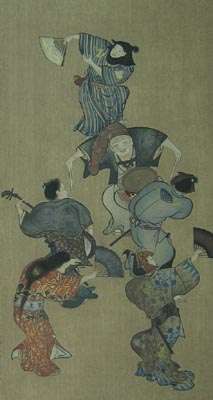
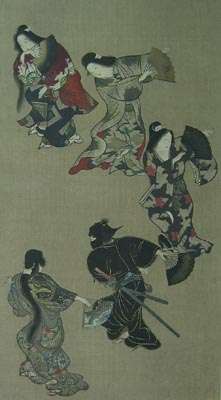 15. A Girl Dancer Tosa School
15. A Girl Dancer Tosa School
 16. View in The Vicinity of Kyoto Tosa School
16. View in The Vicinity of Kyoto Tosa School
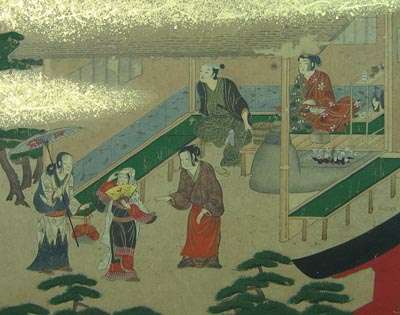 Part Two
17. Poet Kakinomoto no Hitomaru By Matabei Iwasa
Part Two
17. Poet Kakinomoto no Hitomaru By Matabei Iwasa
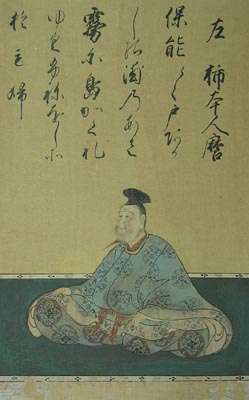 18. Poetess Nakatsukasa By Matabei Iwasa
18. Poetess Nakatsukasa By Matabei Iwasa
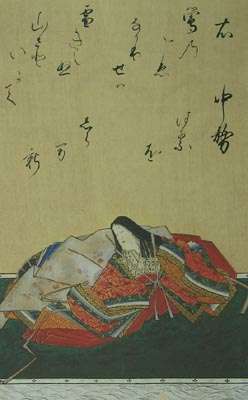 19-20. Men and Women Playing Together By Matabei Iwasa
19-20. Men and Women Playing Together By Matabei Iwasa

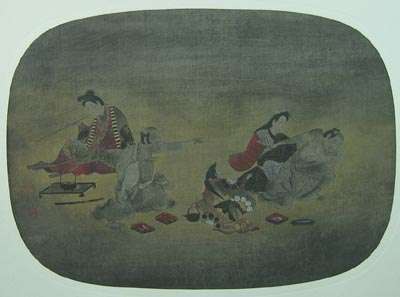 21-22. Men and Women Playing and Dancing Together By Matabei Iwasa
21-22. Men and Women Playing and Dancing Together By Matabei Iwasa

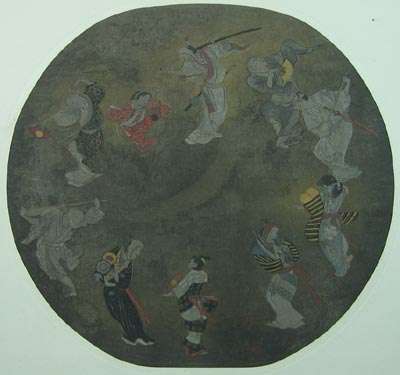 23-24. Men and Women Tranquilly Playing Together By Matabei Iwasa
23-24. Men and Women Tranquilly Playing Together By Matabei Iwasa

 25. Hermitess Lo-fou By Matabei Iwasa
25. Hermitess Lo-fou By Matabei Iwasa
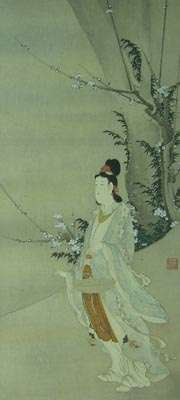 26. Tsurayuki Kino By Matabei Iwasa
26. Tsurayuki Kino By Matabei Iwasa
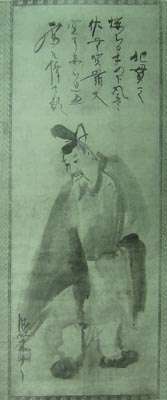 27. A Cherry-blossom Party Iwasa School
27. A Cherry-blossom Party Iwasa School
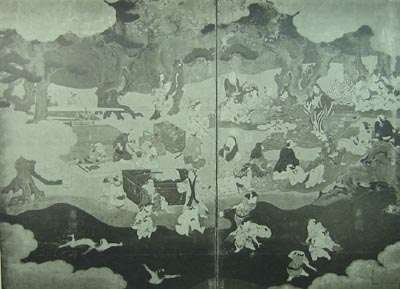 Part Three The Hishikawa School
28. The Sumida-gawa, A Theatrical Picture By Moronobu Hishikawa
Part Three The Hishikawa School
28. The Sumida-gawa, A Theatrical Picture By Moronobu Hishikawa
 29-30. Futari Saruwaka, A Theatrical Picture:
A House of Ill-fame By Moronobu Hishikawa
29-30. Futari Saruwaka, A Theatrical Picture:
A House of Ill-fame By Moronobu Hishikawa

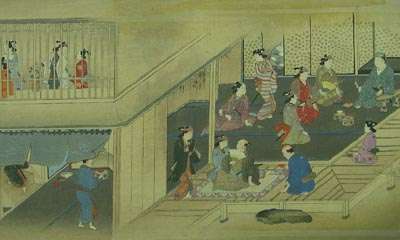 31. A Beauty in Profile By Moronobu Hishikawa
31. A Beauty in Profile By Moronobu Hishikawa
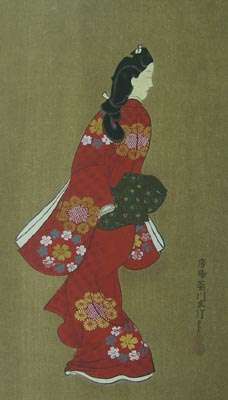 32. A Beauty and A Young Man By Moronobu Hishikawa
32. A Beauty and A Young Man By Moronobu Hishikawa
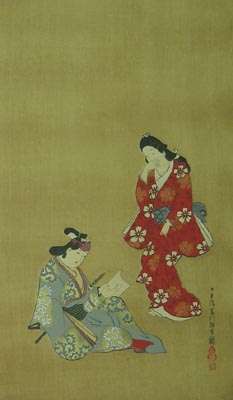 33. A Beautiful Girl with Her Maid By Morofusa Hishikawa
33. A Beautiful Girl with Her Maid By Morofusa Hishikawa
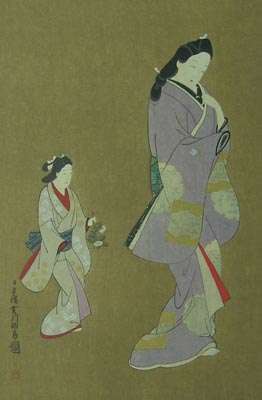 34. Ryogoku Bridge By Moroshige Hishikawa
34. Ryogoku Bridge By Moroshige Hishikawa
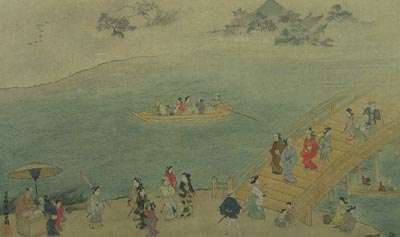 35. A Youth Carrying A Lady By Morohim Hishikawa
35. A Youth Carrying A Lady By Morohim Hishikawa
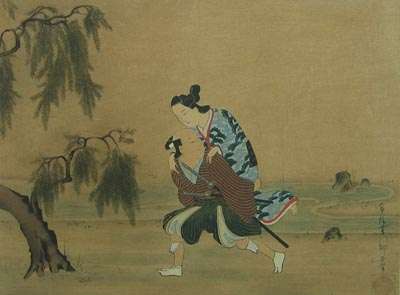 36. A Theatrical Picture By Wawo Hishikawa
36. A Theatrical Picture By Wawo Hishikawa
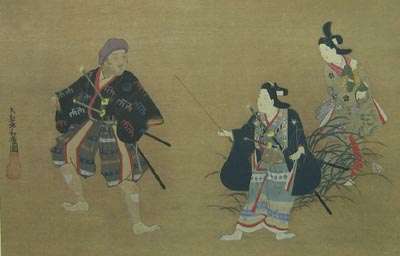 37. A House of Ill-fame By Tomofusa Hishikawa
37. A House of Ill-fame By Tomofusa Hishikawa
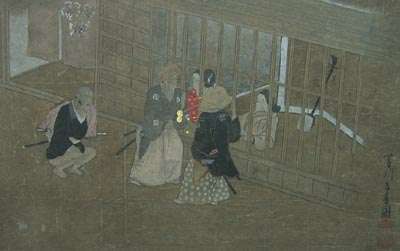 38. Poetess Komachi Washing The Book By Morotsugi Furuyama
38. Poetess Komachi Washing The Book By Morotsugi Furuyama
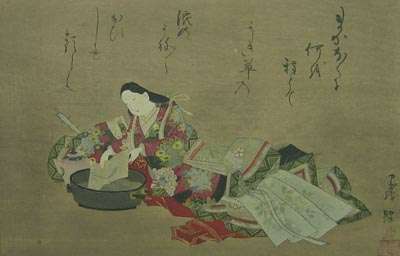 39. A Beauty Under A Plum-tree By Moromasa Furuyaina
39. A Beauty Under A Plum-tree By Moromasa Furuyaina
 40. A Beautiful Girl with Her Maid By Moromasa Furuyama
40. A Beautiful Girl with Her Maid By Moromasa Furuyama
 32 color, 8 black & white collotype
Black and white plate nos. are underlined above.
Listing of Plates (above repeated but with no illustrations)
Volume I. List of Plates
1. Women Looking at The Maple-Trees at Takao,
near Kyoto By Hideyori Kano
2-3. The Festival of Toyokuni Daimyojin By Naisen Kano
4. Ship being Unloaded Kano School
5. House Building Kano School
6. Shooting Kano School
7.. Horse Training Kano School
8. The Hikone Screen Kano School
9. Women Tranquilly Playing Artist Unknown
10-11. Kabuki no Soshi (Dramatic Pictures) Kano School
12. A Beauty and A Little Girl Artist Unknown
13-14. Groups of Men and Women Dancing Together Artist Unknown
15. A Girl Dancer Tosa School
16. View in The Vicinity of Kyoto Tosa School
Part Two
17. Poet Kakinomoto no Hitomaru By Matabei Iwasa
18. Poetess Nakatsukasa By Matabei Iwasa
19-20. Men and Women Playing Together By Matabei Iwasa
21-22. Men and Women Playing and Dancing Together By Matabei Iwasa
23-24. Men and Women Tranquilly Playing Together By Matabei Iwasa
25. Hermitess Lo-fou By Matabei Iwasa
26. Tsurayuki Kino By Matabei Iwasa
27. A Cherry-blossom Party Iwasa School
Part Three The Hishikawa School
28. The Sumida-gawa, A Theatrical Picture By Moronobu Hishikawa
29-30. Futari Saruwaka, A Theatrical Picture:
A House of Ill-fame By Moronobu Hishikawa
31. A Beauty in Profile By Moronobu Hishikawa
32. A Beauty and A Young Man By Moronobu Hishikawa
33. A Beautiful Girl with Her Maid By Morofusa Hishikawa
34. Ryogoku Bridge By Moroshige Hishikawa
35. A Youth Carrying A Lady By Morohim Hishikawa
36. A Theatrical Picture By Waivo Hishikawa
37. A House of Ill-fame By Toinofusa Hishikawa
38. Poetess Komachi Washing The Book By Morotsugi Funtyama
39. A Beauty Under A Plum-tree By Moromasa Fumyaina
40. A Beautiful Girl with Her Maid By Moroniasa Fumyama
32 color, 8 black & white collotype
Black and white plate nos. are underlined above.
Listing of Plates (above repeated but with no illustrations)
Volume I. List of Plates
1. Women Looking at The Maple-Trees at Takao,
near Kyoto By Hideyori Kano
2-3. The Festival of Toyokuni Daimyojin By Naisen Kano
4. Ship being Unloaded Kano School
5. House Building Kano School
6. Shooting Kano School
7.. Horse Training Kano School
8. The Hikone Screen Kano School
9. Women Tranquilly Playing Artist Unknown
10-11. Kabuki no Soshi (Dramatic Pictures) Kano School
12. A Beauty and A Little Girl Artist Unknown
13-14. Groups of Men and Women Dancing Together Artist Unknown
15. A Girl Dancer Tosa School
16. View in The Vicinity of Kyoto Tosa School
Part Two
17. Poet Kakinomoto no Hitomaru By Matabei Iwasa
18. Poetess Nakatsukasa By Matabei Iwasa
19-20. Men and Women Playing Together By Matabei Iwasa
21-22. Men and Women Playing and Dancing Together By Matabei Iwasa
23-24. Men and Women Tranquilly Playing Together By Matabei Iwasa
25. Hermitess Lo-fou By Matabei Iwasa
26. Tsurayuki Kino By Matabei Iwasa
27. A Cherry-blossom Party Iwasa School
Part Three The Hishikawa School
28. The Sumida-gawa, A Theatrical Picture By Moronobu Hishikawa
29-30. Futari Saruwaka, A Theatrical Picture:
A House of Ill-fame By Moronobu Hishikawa
31. A Beauty in Profile By Moronobu Hishikawa
32. A Beauty and A Young Man By Moronobu Hishikawa
33. A Beautiful Girl with Her Maid By Morofusa Hishikawa
34. Ryogoku Bridge By Moroshige Hishikawa
35. A Youth Carrying A Lady By Morohim Hishikawa
36. A Theatrical Picture By Waivo Hishikawa
37. A House of Ill-fame By Toinofusa Hishikawa
38. Poetess Komachi Washing The Book By Morotsugi Funtyama
39. A Beauty Under A Plum-tree By Moromasa Fumyaina
40. A Beautiful Girl with Her Maid By Moroniasa Fumyama
Colophon

Printed: Meiji 39 (1906).6.20
Published: Meiji 39 (1906).6.25
Folding case
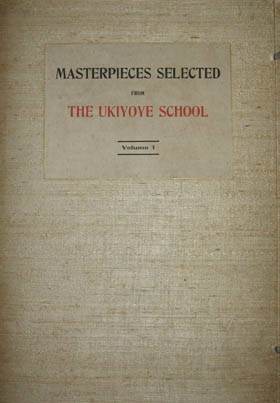
Volume I
Volume II
Volume III
Volume IV
Volume V
To return to main page for Shimbi Shoin publications, click here.
General Information
on the Five Volume Set
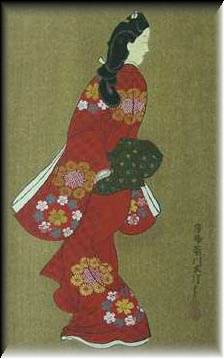
Tajima Shiichi (editor)
Omura Seigai (text)
Goodrich, Joseph King (translation into English):
Masterpieces Selected from the Ukiyoye School (Eibun Ukiyoe-Ha Gashu), Shimbi Shoin, Tokyo, 1906-9 (Meiji 39-42), Volumes I-V, folio (13 1/2 x 19 1/2 in - 34.2 x 49.5 cm), silk covered boards decorated with a woodblock illustration on the front board, edges beveled, spine covered in brocade silk cloth, purple silk ties, volume number and title in English in gilt on front board, top and bottom page edges in gilt, text in English, 170 plates (158 color woodblock and 12 black and white collotype), 214 pp (210 numbered text pages and a 4 page preface). Each plate is preceded by a tissue guard with information in English regarding the plate that follows. There are numerous black and white text illustrations in the text pages. While most are woodcuts, a few are collotypes. Issued with a straw textured wrap-around case with ivory type clasps. According to Shimbi Shoin catalogues "Regular," "Special" and "De Luxe" editions were issued. Each volume in the set contains a numbered limitation statement indicating the number of the set out of total sets printed.
A Japanese language version (Eibun Ukiyoe-Ha Gashu) or (Ukiyoye-ha Gwashu) was also published. This 5 volume set is reported to contain a total of 150 plates, 20 less than in the English language set.
One of the largest plates in the English language version is number 155 in volume 5 which reproduces a triptych titled "Part of a Roll Representing Various Fashions in the Four Seasons" by Yeishi Hosoda. This plate has an image area of 30.5 x 77 cm and has three folds out. It is apparently not found in the Japanese language version of the set.
The Shimbi Shoin outlines in detail the color woodblock (chromoxylograph) process it uses in Process of Wood-Cut Printing Explained. This description can be found here.
English Language Version ---- Japanese Language Version
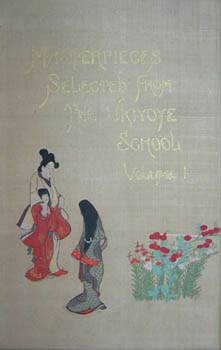
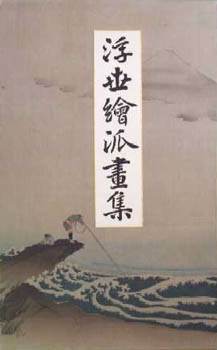
Volumes 1- 5 of he ordinary edition are digitally archived here - the collection of the family of Henry Posner, Sr. at Carnegie Mellon University.
Wenckstern calls the book Masterpieces Selected from the Ukiyoye [popular] School and states:
...in five volumes of 30 plates each. Volume I contains an essay on the origin and development of the Ukiyoye school, biographical data sketches of the artist and some critical descriptions. 35 pp text and 39 plates. (Edition de luxe, 100 copies, 250 yen the set; ordinary edition, 600 copies, 200 yen the set.
Early Shimbi Shoin catalogues described the set with 150 pictures (plates). Later catalogues modified that to 170. Booksellers have reported the set with 175 plates but I have not been able to confirm that as accurate. It is possible that the 175 number was the number of woodblock prints. Some plates contain more than one woodblock print. Volume IV contains 5 color illustrations (probably woodblocks) incorporated as illustrations into the text section.
An early, but undated, Shimbi Shoin catalogue states that the edition was limited to 700 copies and of that total 100 were deluxe editions. This catalogue listed three editions:
Edition de luxe - 26 GB Pounds
Special Edition - 23 GB Pounds
Ordinary Edition - 21 GB Pounds
This catalogue stated:
5. The number of volumes in this edition is limited to Seven hundred copies, including 100 copies of the edition de luxe and 100 copies of the special edition (that is bound in a more attractive way that the ordinary edition and some of such pictures as were originally painted on silk will be reproduced in silk). Each volume in the entire series is numbered and registered, as a guarantee of its genuineness.
The number of this set printed is uncertain. To compound this problem, it is unclear whether the printing numbers are for the English language version, the Japanese language version, or both.
600 sets - Ordinary Edition
200-300 sets - Special Edition*
100 sets - Edition de Luxe
900~1000 sets total
* A "special edition" set with a limitation statement of 200 but with number "300" has been confirmed.
By 1920, Shimbi Shoin catalogues dropped reference to the "Edition de luxe." Perhaps this was because they were sold out.
The editor, Shiichi Tajima, was also the editor of Selected Relics of Japanese Art, a 20 volume set published between 1899 and 1908. These set was very similar in composition to this book. It featured prominent Japanese art reproduced in collotype and woodblock. During the period of 1902-7, the The Kwansai Photograph Company produced the collotype plates used in that set.
Plate Types by Volume
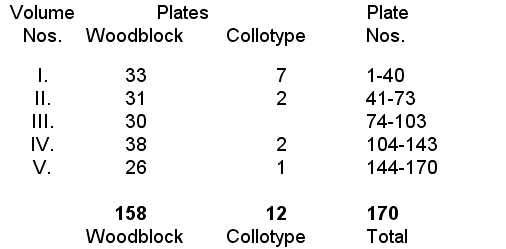
The actual dimensions of the plates range from a woodblock prints tipped to a page (page size is 12 x 19 1/4 in - 30.5 x 49 cm) and occupying 60-80% of the page to massive fold-out plates like plate 48 in Volume II. That plate has four folds out and the woodblock print that is tipped to page is almost 3 feet long by almost 1 foot high.

Plate 48 - 3 folds out
Page Size: 19 1/4 x 40 1/4 in - 49 x 101.5 cm
Woodblock Print Size: 11 x 35 1/2 in - 28 x 94 cm
Listing of Plates can be reviewed here:
Volume I
Volume II
Volume III
Volume IV
Volume V
Contents of the five volumes cover:
Volume I 1906 (Meiji 39) - [Plates 1-40]
Part One. Genre of Before and About the Keicho and the Kwanye
Eras (1596-1643) - Plates 1-16.
Part Two. Matabei Iwasa - Plates 17-27
Part Three. The Hishikawa School - Plates 28-40
Chapter I. Moronobu Hishikawa
Chapter II. Morofusa Hishikawa
Chapter III. Moroshige Hishikawa
Chapter IV. Morohira Hishikawa
Chapter V. Wawo Hishikawa
Chapter VI. Tomofusa Hishikawa
Chapter VII. Morotsugi Furuyama
Chapter VIII. Moromasa Furuyama
33 color woodblock plates
7 black and white collotypes
Volume II 1907 (Meiji 40) - [Plates 41-73]
Part Four Miyagawa School - Plates 41-54.
Chapter I. Choshun Miyagawa
Chapter II. Shunsui Katsu-Miyagawa
Chapter III. Choki Miyagawa; Masayuki Miyagawa;
Issho Miyagawa, and Shinsui Katsukawa
Part Five Katsukawa School - Plates 55-73
Chapter I. Shunsho Katsukawa
Chapter II. Shuncho Katsukawa
Chapter III. Shunye Katsukawa
Chapter IV. Shunko Katsukawa
Chapter V. Shundo Katsukawa
Chapter VI. Shunkaku, Shunjo, Shunkyo, Shunko, Shunrin
Shunkyoku, Shunsen, Shungyo and Kyokko Katsukawa
Chapter VII. Shuntei Katsukawa
Chapter VIII. Shunsen Katsukawa
Chapter IX. Shunzan Katsukawa
Chapter X. Shuntoku and Shundo Katsukawa
31 color woodblock plates
2 black and white collotype plates
Volume III 1908 (Meiji 41) - [Plates 74 - 103]
Part Six Kwaigetsudo School
Chapter I. Founder of the Kwaigetsudo School
Chapter II. Disciples of Kwaigetsudo
Part Seven Torii School
Chapter I. Kiyomoto Torii
Chapter II. Kiyonobe Torii
Chapter III. Kiyomasu Torii
Chapter IV. Chincho Hagawa
Chapter V. Kiyomitsu Torii
Chapter VI. Kiyotsune Torii
Chapter VII. Kiyonaga Torii
Chapter VIII. Kiyomine Torii (The Second Kiyomitsu)
Chapter IX. Kiyotada Torii
Chapter X. Kiyoyoshi Torii (The Third Kiyomitsu)
Part Eight
Chapter I. Shigenaga and Shigenobu Nishimura
Chapter II. Toyonobu and Toyomasa Ishikawa
Chapter III. Koryosai Isoda
Chapter IV. Harunobu Suzuki
Chapter V. Fusanobu Tomikawa
Part Nine Toriyama School
Chapter I. Toriyama School
Chapter II. Harumachi Koikawa
Chapter III. Shiko Momokawa
30 color woodblock plates
0 black and white collotype plates
Volume IV 1907 (Meiji 40) - [Plates 104 - 143]
Part Ten Okumura School - Plates 104-107
Chapter I. Masanobu Okumura
Chapter II. Toshinobu and Masafusa
Part Eleven Kitao School - Plates 108-116
Chapter I. Shigemasa Kitao
Chapter II. Masanobu Kiato
Chapter III. Masayoshi Kiato
Chapter IV. Shunman Kubota
Chapter V. Ryuko Kitao and Yoshimura Kiato
Part Twelve Utagawa School - Plates 117-127
Chapter I. Toyoharu Utagawa
Chapter II. Toyohiro Utagawa
Chapter III. Toyokuni Utagawa
Chapter IV. Kunisada Utagawa
Chapter V. Kuniyoshi Utagawa
Chapter VI. Hiroshige Utagawa
Part Thirteen Katsushika School - Plates 128-143
Chapter I. Hokusai Katsushika
Chapter II. Hokutai Katsushika
Chapter III. Hokuba Arisaka
Chapter IV. Hokkei Totoya
Chapter V. Shigenobu Yanagawa
Chapter VI. Shinsai Ryuryukyo
38 color woodblock plates
2 black and white collotype plates
Volume V 1909 (Meiji 42) - [Plates 144-170]
Part Fourteen Kitagawa School Plates 144-150
Chapter I. Utamaro Kitagawa
Chapter II. Disciples of Utamaro
Part Fifteen Hosoda School Plates 151-158
Chapter I. Yeishi Hosoda
Chapter II.
Chapter III.
Chapter IV. Disciples of Yeishi
Part Sixteen Kikugawa School Plates 159
Chapter I. Yeizan Kikugawa
Chapter II. Keisai Yeisen
Chapter III. Yeisho Kikugawa
Chapter IV. Disciples of Yeisen
Part Seventeen Hanabusa School Plates 160-164
Chapter I. Itcho Hanabusa
Chapter II. Sushi Sawaki and Sukoku Ko
Part Eighteen Miscellaneous Artists of Kyoto and Osaka Plates 165-170
Chapter I. Rippo Hinaya
Chapter II. Sukenobu Nishikawa
26 color woodblock plates
1 black and white collotype
Wrap-Around Case. Issued with a straw/grass textured wrap-around cases (chitsu cases) with printed silk title label and two ivory type clasps.
Limitation Statements. After the half title page in each volume there is an illustrated limitation statement. The illustration is different in each volume. The number is sometimes written in English and sometimes in Japanese and it is incorporated into text portion of the illustration. The limitation statements indicate the number of the set out of the total published. Some limitation statements reference "Six Hundred Copies" (ordinary or regular edition). Others reference "Two Hundred Copies" of a "Special Edition." I have not examined a limitation statement from a "Edition de luxe." Below are limitation statements for the ordinary and special editions found in Volume I.
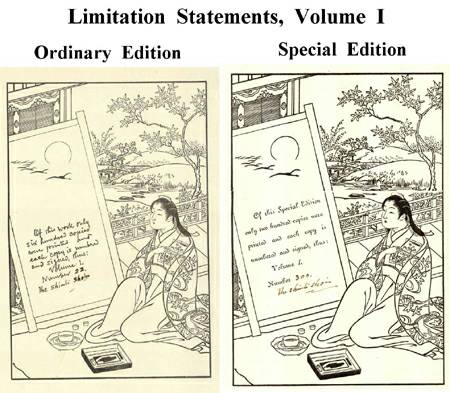
Paper Types. High quality paper was used in the production of this set. The following paper types are noted.
- Medium paper stock (folded and unfolded). Front and back blank pages (unfolded), half title page (folded), limitation statement page (folded), full title page (folded).
- Thin paper stock (folded and unfolded). Text pages(folded) and descriptive tissue guards (unfolded), list of plates (folded) & colophon (folded). Fold-out collotype plates are printed on thin paper which is then tipped to the heavy card stock plate page in the book.
- Heavy card stock (always unfolded). All plates (woodblock and collotype) are mounted to thick/heavy card stock plate pages in the book. The woodblock prints are tipped to thick/heavy card stock plate pages. In the case of fold-out woodblock plates, they are tipped to heavy card stock paper that is then glued along one edge to the plate page in the book. Non-folding collotype plates are printed directly on thick/heavy card stock.
Descriptive Tissue Guards. The plates are preceded by descriptive tissue guards. An example of the text is here. Often, a descriptive tissue guard will apply to more than one plate. These descriptions provide:
- Title of the Art
- Artist or School
- Type of Work (ie screen, painting)
- Dimensions of the Original Work
- Owner.
Typical Collation. Blank page (front), half title page/limitation statement page, full title page/back blank, list of plates/back blank, text pages, plates, text pages, plates, colophon/back blank & blank page (back).
|
